Modern Power Electronics and AC Drives
Preface
List of Principal Symbols
Chapter 1 Power Semiconductors Devices
1.2 Diodes
1.1 Introduction
1.3 Thyristors
1.3.1 Volt Ampere Characteristics
1.3.2 Switching Characteristics
1.3.3 Power Loss and Thermal Impedance
1.3.4 Current Rating
1.4 Triacs
1.5 Gate Turn-Off Thyristors (GTOs)
1.5.1 Switching Characteristics
1.5.2 Regenerative Snubbers
1.6 Bipolar Power or Junction Transistors (BPTs or BJTs)
1.7 Power MOSFETs
1.7.1 V-I Characteristics
1.7.2 Safe Operating Area (SOA)
1.8 Static Induction Transistors (SITs)
1.9 Insulated Gate Bipolar Transistors (IGBTs)
1.9.1 Switching Cgaracteristics and Thermal Impedance
1.10 MOS-Controlled Thyristors (MCTs)
1.11 Integrated Gate-Commutated Thyristors (IGCTs)
1.12 Large Band-Gap Materials for Devices
1.13 Power Integrated Circuits (PICs)
1.14 Summary
Chapter 2 AC Machines for Drivers
2.1 Introduction
2.2 Induction Machines
2.2.1 Rotating Magnetic Field
2.2.2 Torque Production
2.2.3 Equivalent Circuit
2.2.4 Torque-Speed Curve
2.2.5 NEMA Classification of Machines
2.2.6 Variable-Voltage, Constant-Frequency Operation
2.2.7 Variable-Frequency Operation
2.2.8 Constant Volts/Hz Operation
2.2.9 Drive Operating Regions
2.2.10 Variable Stator Current Operation
2.2.11 The Effect of Harmonics
2.2.11.1 Harmonic Heating
2.2.11.2 Machine Parameter Variation
2.2.11.3 Torque Pulsation
2.2.12 Dynamic d-q Model
2.2.12.1 Axes Transformation
2.2.12.2 Synchronously Rotating Reference Frame - Dynamic Model (Kron Equation)
2.2.12.3 Stationary Frame - Dynamic Model (Stanley Equation)
2.2.12.4 Dynamic Model State-Space Equations
2.3 Synchronous Machines
2.3.1 Wound Field Machine
2.3.1.1 Equivalent Circuit
2.3.1.2 Developed Torque
2.3.1.3 Salient Pole Machine Characteristics
2.3.1.4 Dynamic d-q Machine Model (Park Model)
2.3.2 Synchronous Reluctance Machine
2.3.3 Permanent Magnet (PM) Machine
2.3.3.1 Permanent Magnet Materials
2.3.3.2 Sinusoidal Surface Magnet Machine (SPM)
2.3.3.3 Sinusoidal Interior Magnet Machine (IPM)
2.3.3.4 Trapezoidal Surface Magnet Machine
2.4 Variable Reluctance Machine (VRM)
2.5 Summary
Chapter 3 Diodes and Phase-Controlled Converters
3.1 Introduction
3.2 Diode Rectifiers
3.2.1 Single-Phase Bridge - R, RL Load
3.2.2 Effect of Source Inductance
3.2.3 Single-Phase Bridge - RL, CEMF Load
3.2.4 Single-Phase Bridge - CR Load
3.2.5 Distortion, Displacement, and Power Factors
3.2.6 Distortion Factor (DF)
3.2.7 Displacement Power Factor (DPF)
3.2.8 Power Factor (PF)
3.2.9 Three-Phase Full Bridge - RL Load
3.2.10 Three-Phase Bridge - CR Load
3.3 Thristor Converters
3.3.1 Single-Phase Bridge - RL, CEMF Load
3.3.2 Discontinuous Conduction
3.3.3 Three-Phase Converter - RL, CEMF Load
3.3.4 Three-Phase, Half-Wave Converter
3.3.5 Analysis for Line Leakage Inductance (Lc)
3.3.6 Three-Phase Bridge Converter
3.3.7 Discontinuous Conduction
3.3.8 Three-Phase Dual Converter
3.3.9 Six-Pulse, Center-Tap Converter
3.3.10 12-Pulse Converter
3.3.11 Concurrent and Sequential Control of bridge Converters
3.4 Converter Control
3.4.1 Linear Firing Angle Control
3.4.2 Cosine Wave Crossing Control
3.4.3 Phase-Locked Oscillator Principle
3.5 EMI and Line Power Quality Problems
3.5.1 EMI Problems
3.5.2 Line Harmonic Problems
3.6 Summary
Chapter 4 Cycloconverters
4.1 Introduction
4.2 Phase-Controlled Cycloconverters
4.2.1 Operation Principles
4.2.2 A Three-Phase Dual Converter as Cycloconverter
4.2.3 Cycloconverter Circuits
4.2.3.1 Three-Phase, Half-Wave Cycloconverter
4.2.3.2 Three-Phase Bridge Cycloconverter
4.2.3.2.1 Modulation Factor
4.2.4 Circulating vs. Non-Circulating Current Mode
4.2.4.1 Circulating Current Mode
4.2.4.2 Blocking Mode
4.2.5 Load an Line Harmonics
4.2.5.1 Load Voltage Harmonics
4.2.5.2 Line Current Harmonics
4.2.6 Line Displacement Power Factor
4.2.6.1 Theoretical Derivation of Line DPF
4.2.7 Control of Cycloconverter
4.2.8 DPF Improvement Methods
4.2.8.1 Square-Wave Operation
4.2.8.2 Asymmetrical Firing Angle Control
4.2.8.3 Circulating Current Control
4.3 Matrix Converters
4.4 High-Frequency Cycloconverters
4.4.1 High-Frequency, Phase-Controlled Cycloconverter
4.4.2 High-Frequency, Integral-Pulse Cycloconverter
4.4.2.1 Sinusoidal Supply
4.4.2.2 Quasi-Square-Wave Supply
4.5 Summary
Chapter 5 Voltage-Fed Converters
5.1 Introduction
5.2 Single-Phase Inverters
5.2.1 Half-Bridge and Center-Tapped Inverters
5.2.2 Full, or H-Bridge, Inverter
5.2.2.1 Phase-Shift Voltage Control
5.3 Three-Phase Bridge Inverters
5.3.1 Square-Wave, or Six-Step, Operation
5.3.2 Motoring and Regenerative Modes
5.3.3 Input Ripple
5.3.4 Device Voltage and Current Ratings
5.3.5 Phase-Shift Voltage Control
5.3.6 Voltage and Frequency Control
5.4 Multi-Stepped Inverters
5.4.1 12-Step Inverter
5.4.2 18-Step Inverter by Phase-Shift Control
5.5 Pulse Width Modulation Techniques
5.5.1 PWM Principle
5.5.1.1 PWM Classification
5.5.1.1.1 Sinusoidal PWM
5.5.1.1.2 Selected Harmonic Elimination PWM
5.5.1.1.3 Minimum Ripple Current PWM
5.5.1.1.4 Space-Vector PWM
5.5.1.1.5 Sinusoidal PWM with Instantaneous Current Control
5.5.1.1.6 Hysteresis-Band Current Control PWM
5.5.1.1.7 Sigma-Delta Modulation
5.6 Three-Level Inverters
5.6.1 Control of Neutral Point Voltage
5.7 Hard Switching Effects
5.8 Resonant Inverters
5.9 Soft-Switched Inverters
5.9.1 Soft Switching Principle
5.9.1.1 Inverter Circuits
5.10 Dynamic and Regenerative Drive Braking
5.10.1 Dynamic Braking
5.10.2 Regenerative Braking
5.11 PWM Rectifiers
5.11.1 Diode Rectifier with Boost Chopper
5.11.1.1 Single-Phase
5.11.1.2 Three-Phase
5.11.2 PWM Converter as Line-Side Rectifier
5.11.2.1 Single-Phase
5.11.2.2 Three-Phase
5.12 Static VAR Compensators and Active Harmonic Filters
5.13 Introduction to Simulation - MATLAB/SIMULINK
5.14 Summary
Chapter 6 Current-Fed Converters
6.1 Introduction
6.2 General Operation of Six-Step Thyristor Inverter
6.2.1 Inverter Opereation Modes
6.2.1.1 Mode 1: Load-Commutated Rectifier
6.2.1.2 Mode 2: Load-Commutated Inverter
6.2.1.3 Mode 3: Force-Commutated Inverter
6.2.1.4 Mode 4: Force-Commutated Rectifier
6.3 Load-Commutated Inverters
6.3.1 Single-Phase Resonant Inverter
6.3.1.1 Circuit Analysis
6.3.2 Three-Phase Inverter
6.3.2.1 Lagging Power Factor Load
6.3.2.2 Over-Excited Synchronous Machine Load
6.3.2.3 Synchronous Motor Starting
6.4 Force-Commutated Inverters
6.4.1 Auto-Sequential Current-Fed Inverter (ASCI)
6.5 Harmonic Heating and Torque Pulsation
6.6 Multi-Stepped Inverters
6.7 Inverters with Self-Commutated Devices
6.7.1 Six-Step Inverter
6.7.1.1 Load Harmonic Resonance Problem
6.7.2 PWM Inverters
6.7.2.1 Trapezoidal PWM
6.7.2.2 Selected Harmonic Elimination PWM (SHE-PWM)
6.7.3 Double-Sided PWM Converter System
6.7.4 PWM Rectifier Applications
6.7.4.1 Static VAR Compensator/Active Filter
6.7.4.2 Superconducting Magnet Energy Storage (SMES)
6.7.4.3 DC Motor Speed Control
6.8 Current-Fed vs. Voltage-Fed Converters
6.9 Summary
Chapter 7 Induction Motor Slip-Power Recovery Drives
7.1 Introduction
7.2 Doubly-Fed Machine Speed Control by Rotor Rheostat
7.3 Static Kramer Drive
7.3.1 Phasor Diagram
7.3.2 AC Equivalent Circuit
7.3.3 Torque Expression
7.3.4 Harmonics
7.3.5 Speed Control of a Kramer Drive
7.3.6 Power Factor Improvement
7.4 Static Scherius Drive
7.4.1 Modef of Operation
7.4.2 Modified Scherbius Drive for VSCF Power Generation
7.5 Summary
Chapter 8 Control and Estimation of Induction Motor Drives
8.1 Introduction
8.2 Induction Motor Control with Small Signal Model
8.2.1 Small-Signal Model
8.3 Scalar Control
8.3.1 Voltage-Fed Inverter Control
8.3.1.1 Open Loop Volts/Hz Control
8.3.1.2 Energy Conservation Effect by Variable Frequency Drive
8.3.1.3 Speed Control with Slip Regulation
8.3.1.4 Speed Control with Torque and Flux Control
8.3.1.5 Current-Controlled Voltage-Fed Inverter Drive
8.3.1.6 Traction Drives with Parallel Machines
8.3.2 Current-Fed Inverter Control
8.3.2.1 Independent Current and Frequency Control
8.3.2.2 Speed and Flux Control in Current-Fed Inverter Drive
8.2.2.3 Volts/Hz Control of Current-Fed Inverter Drive
8.3.3 Efficiency Optimization Control by Flux Program
8.4 Vector or Field-Oriented Control
8.4.1 DC Drive Analogy
8.4.2 Equivalent Circuit and Phasor Diagram
8.4.3 Principles of Vector Control
8.4.4 Direct or Feedback Vector Control
8.4.5 Flux Vector Estimation
8.4.5.1 Voltage Model
8.4.5.2 Current Model
8.4.6 Indirect or Feedforward Vector Control
8.4.6.1 Indirect Vector Control Slip Gain (Ks) Tuning
8.4.7 Vector Control of Line-Side PWM Rectifier
8.4.8 Stator Flux-Oriented Vector Control
8.4.9 Vector Control of Current-Fed Inverter Drive
8.4.10 Vector Control of Cycloconverter Drive
8.5 Sensorless Vector Control
8.5.1 Speed Estimation Methods
8.5.1.1 Slip Calculation
8.5.1.2 Direct Synthesis from State Equations
8.5.1.3 Model Referencing Adaptive System (MRAS)
8.5.1.4 Speed Adaptive Flux Observer (Luenberger Observer)
8.5.1.5 Extended Kalman Filter (EKS)
8.5.1.6 Slot Harmonics
8.5.1.7 Injection of Auxiliary Signal on Salient Rotor
8.5.2 Direct Vector Control without Speed Signal
8.5.2.1 Programmable Cascaded Low-Pass Filter (PCLPF) Stator Flux Estimation
8.5.2.2 Drive Machine Start-up with Current Model Equations
8.6 Direct Torque and Flux Control (DTC)
8.6.1 Torque Expression with Stator and Rotor Fluxes
8.6.2 Control Strategy of DTC
8.7 Adaptive Control
8.7.1 Self-Tuning Control
8.7.1.1 Load Torque Disturbance (Tl) Compensation
8.7.2 Model Referencing Adaptive Control (MRAC)
8.7.3 Sliding Mode Control
8.7.3.1 Control Principle
8.7.3.2 Sliding Trajectory Control of a Vector Drive
8.8 Self-Commissioning of Drive
8.9 Summary
Chapter 9 Control and Estimation of Synchronous Motor Drives
9.1 Introduction
9.2 Sinusoidal SPM Machine Drives
9.2.1 Open Loop Volts/Hertz Control
9.2.2 Self-Control Model
9.2.3 Absolute Position Encoder
9.2.3.1 Optical Encoder
9.2.3.2 Analog Resolver with Decoder
9.2.4 Vector Control
9.2.4.1 Field-Weakening Mode
9.3 Synchronous Reluctance Machine Drives
9.3.1 Current Vector Control of SyRM Drive
9.3.1.1 Constant d - Axis Current Control
9.3.1.2 Fast Torque Response Control
9.3.1.3 Maximum Torque/Ampere Control
9.3.1.4 Maximum Power Factor Control
9.4 Sinusoidal IPM Machine Drives
9.4.1 Current Vector Control with Maximum Torque/Ampere
9.4.2 Field-Weakening Control
9.4.3 Vector Control with Stator Flux Orientation
9.4.3.1 Feedback Signal Processing
9.4.3.2 Square-Wave (SW) Mode Field-Weakening Control
9.4.3.3 PWM - Square-Wave Sequencing
9.5 Trapezoidal SPM Machine Drives
9.5.1 Drive Operation with Inverter
9.5.1.1 Angle Switch-on Mode
9.5.1.2 PWM Voltage and Current Control Mode
9.5.2 Torque-Speed Curve
9.5.3 Machine Dynamic Model
9.5.4 Drive Control
9.5.4.1 Close Loop Speed Control in Feedback Mode
9.5.4.2 Close Loop Current Control in Freewheeling Mode
9.5.5 Torque Pulsation
9.5.6 Extended Speed Operation
9.6 Wound-Field Synchronous Machine Drives
9.6.1 Brush and Brushless dc Excitation
9.6.2 Load-Commutated Inverter (LCI) Drive
9.6.2.1 Control of LCI Drive with Constant Angle
9.6.2.2 Delay angle or Angle control
9.6.2.3 Control with Machine Terminal Voltage Signals
9.6.2.4 Phase-Locked Loop (PLL) Angle Control
9.6.3 Scalar Control of Cycloconverter Drive
9.6.4 Vector Control of Cycloconverter
9.6.5 Vector Control with Voltage-Fed Inverter
9.7 Sensorless Control
9.7.1 Trapezoidal SPM Machine
9.7.1.1 Terminal Voltage Sensing
9.7.1.2 Stator Third Harmonic Voltage Detection
9.7.2 Sinusoidal PM Machine (PMSM)
9.7.2.1 Terminal Voltage and Current Sensing
9.7.2.2 Inductance Variation (sailency) Effect
9.7.2.3 Extended Kalman Filter (EKF)
9.8 Switched Reluctance Motor (SRM) Drives
9.9 Summary
Chapter 10 Expert System Principles and Applications
10.1 Introduction
10.2 Expert System Principles
10.2.1 Knowledge Base
10.2.1.1 Frame Structure
10.2.1.2 Meta-Knowledge
10.2.1.3 ES Language
10.2.2 Inference Engine
10.2.3 User Interface
10.3 Expert System Shell
10.3.1 Shell Features
10.3.2 External Interface
10.3.3 Program Development Steps
10.4 Design Methodology
10.5 Application
10.5.1 P-I Tuning of a Drive
10.5.2 Fault Diagnostics
10.5.3 Selection of Commercial ac Drive Product
10.5.4 Configuration Selection, Design, and Simulation of a Drive System
10.5.4.1 Configuration Selection
10.5.4.2 Motor Ratings Design
10.5.4.3 Converter Design
10.5.4.4 Control Design and Simulation Study
10.6 Glossary
10.7 Summary
Chapter 11 Fuzzy Logic Principles and Applications
11.1 Introduction
11.2 Fuzzy Sets
11.2.1 Membership Functions
11.2.2 Operations on Fuzzy Sets
11.3 Fuzzy System
11.3.1 Implication Methods
11.3.1.1 Mamdani Type
11.3.1.2 Lusing Larson Type
11.3.1.3 Sugeno Type
11.3.2 Defuzzification Methods
11.3.2.1 Center of Area (COA) Method
11.3.2.2 Height Method
11.3.2.3 Mean of Maxima (MOM) Method
11.3.2.4 Sugeno Method
11.4 Fuzzy Control
11.4.1 Why Fuzzy Control
11.4.2 Historical Perspective
11.4.3 Control Principle
11.4.4 Control Implementation
11.5 General design Methotology
11.6 Applications
11.6.1 Induction Motor Speed Control
11.6.2 Flux Programming Efficiency Improvement of Induction Motor Drive
11.6.2.1 Pulsating Torque Compensation
11.6.3 Wind Generation System
11.6.3.1 Wind Turbine Characteristics
11.6.3.2 System Description
11.6.3.3 Fuzzy Control
11.6.4 Slip Gain Tuning of Indirect Vector Control
11.6.4.1 Derivation of Q and v
11.6.5 Stator Resistance Rs Estimation
11.6.6 Estimation of Distorted Waves
11.6.6.2 Sugeno Method
11.6.6.1 Mandami Method
11.7 Fuzzy Logic Toolbox
11.7.1 FIS Editor
11.7.2 Membership Function Editor
11.7.3 Rule Editor
11.7.4 Rule Viewer
11.7.5 Surface Viewer
11.7.6 Demo Program for Synchronous Current Control
11.8 Glossary
11.9 Summary
Chapter 12 Neural Network Principles and Applications
12.1 Introduction
12.2 The Structure of a Neuron
12.2.1 The Concept of a Biological Neuron
12.2.2 Artificial Neuron
12.2.2.1 Activation Functions of a Neuron
12.3 Artificial Neural Network
12.3.1 Application: Y = Asin X
12.3.2 Training of Feedforward Neural Network
12.3.2.1 Learning Methods
12.3.2.2 Alphabet Character Recognition by an ANN
12.3.3 Back Propagation Training
12.3.4 Back propagation Algorithm for Three-Layer Network
12.3.4.1 Weight Calculation for Output Layer Neurons
12.3.4.2 Weight Calculation for Hidden Layer Neurons
12.3.5 On-Line Training
12.4 Other Networks
12.4.1 Radial Basis Function Network
12.4.2 Kohonen's Self-Organizing Feature Map Network
12.4.3 Recurrent Neural Network for Dynamic System
12.4.3.1 Training an RNN by EKF Algorithm
12.5 Neural Network in Identification and Control
12.5.1 Time-Delayed Neural Network
12.5.2 Dynamic System Models
12.5.3 ANN Identification of Dynamic Models
12.5.4 Inverse Dynamics Model
12.5.5 Neural Network-Based Control
12.6 General Design Methodology
12.7 Applications
12.7.1 PWM Controller
12.7.1.1 Selected Harmonic Elimination (SHE) PWM
12.7.1.2 Instantaneous Current Control PWM
12.7.1.3 Space Vector PWM
12.7.2 Vector-Controlled Drive Feedback Signal Estimation
12.7.3 Estimation of Distorted Waves
12.7.4 Model Identification and Adaptive Drive Control
12.7.5 Speed Estimation by RNN
12.7.6 Adaptive Flux Estimation by RNN
12.8 Neuro-Fuzzy Systems
12.8.1 Adaptive Network-Based Fuzzy Inference System (ANFIS)
12.9 Demo Program With Neural Network Toolbox
12.9.1 Introduction to Neural Network Toolbox
12.9.2 Demo Program
12.10 Glossary
12.11 Summary
Index
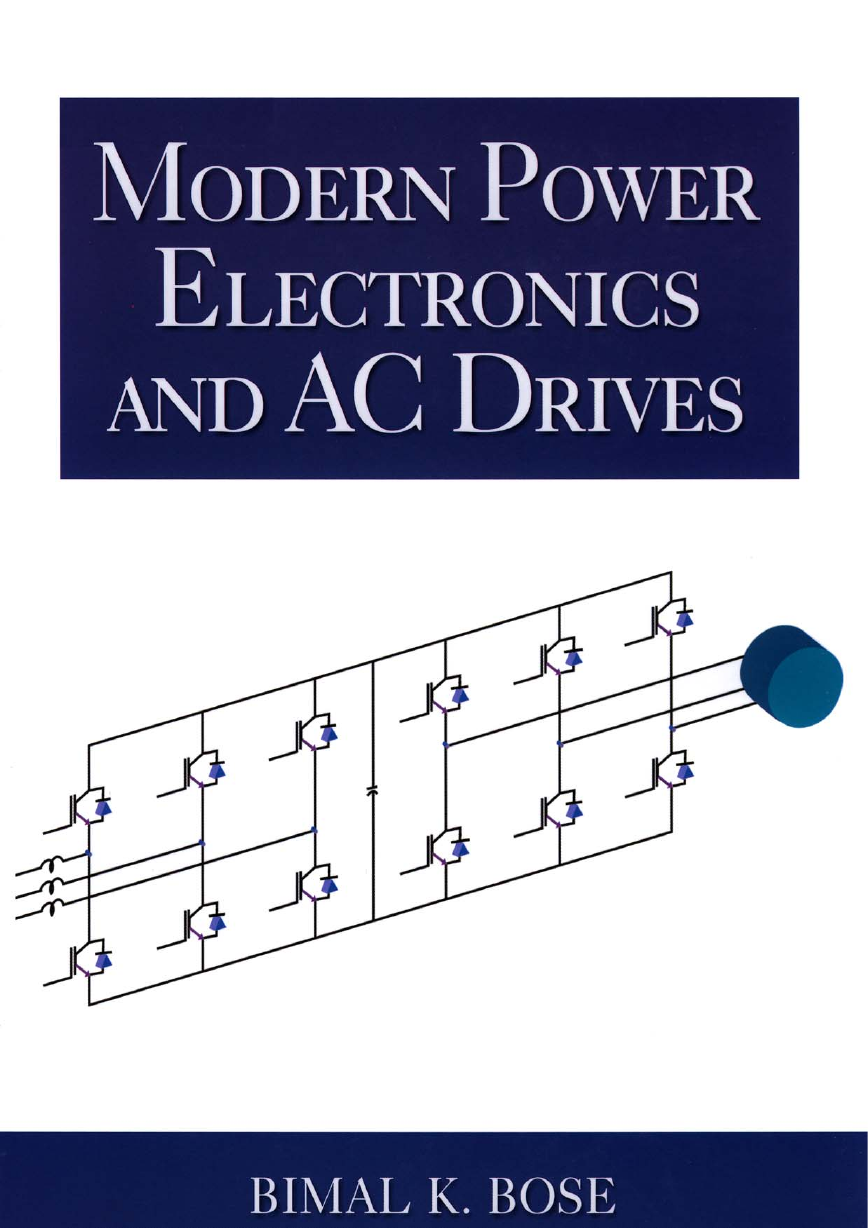

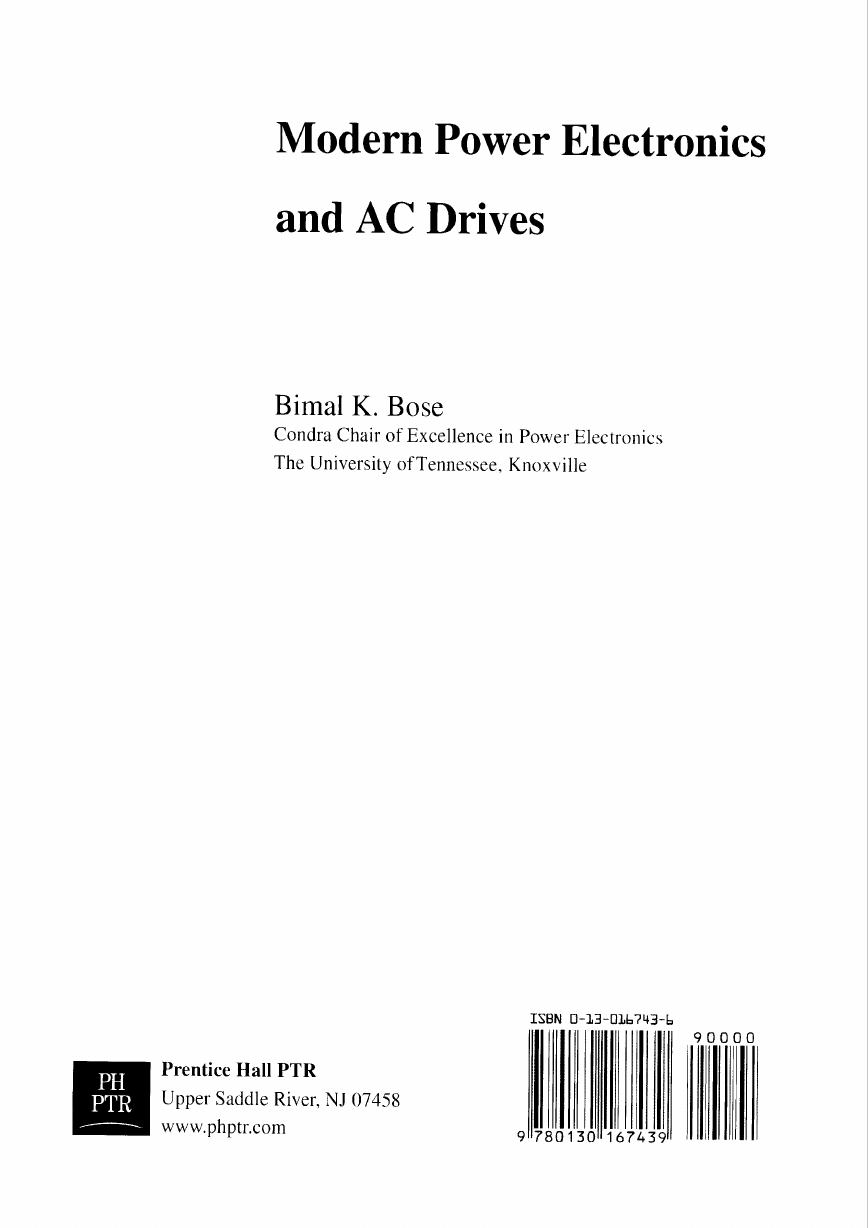
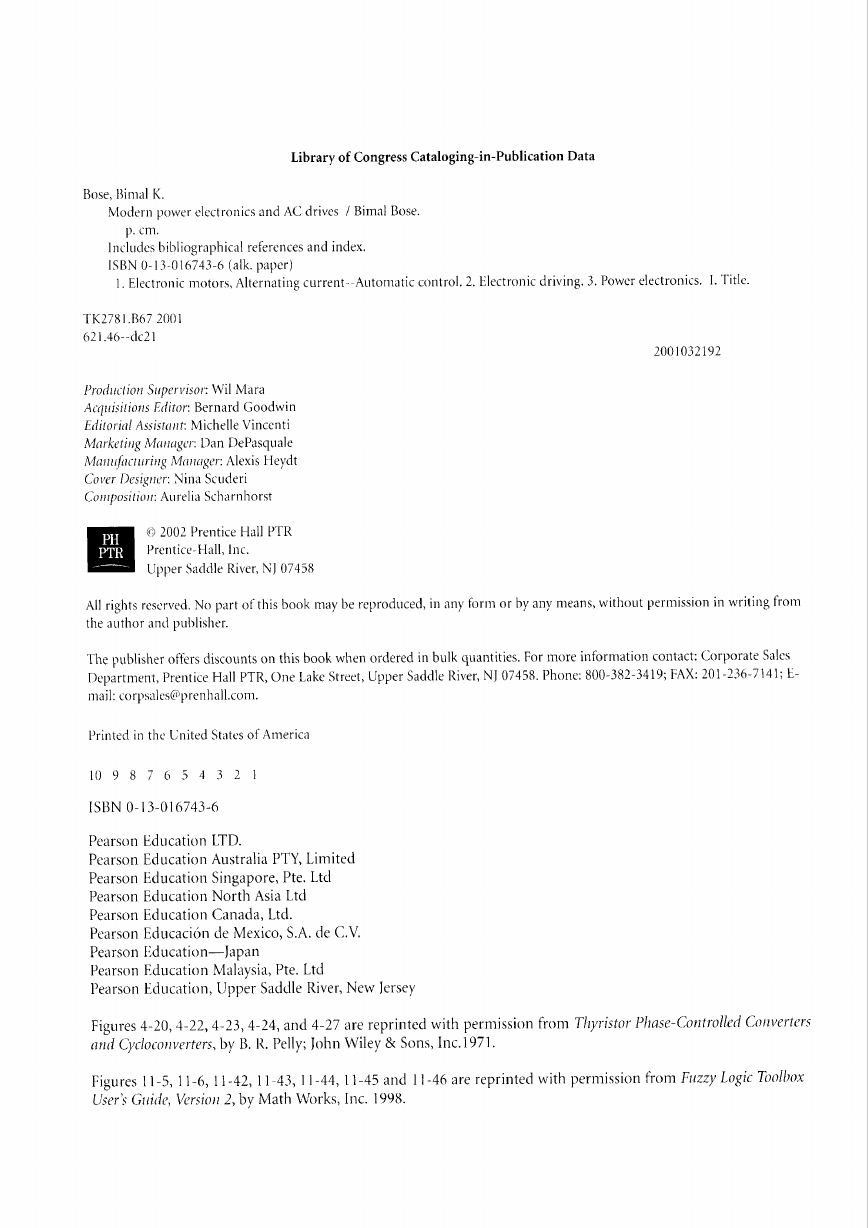
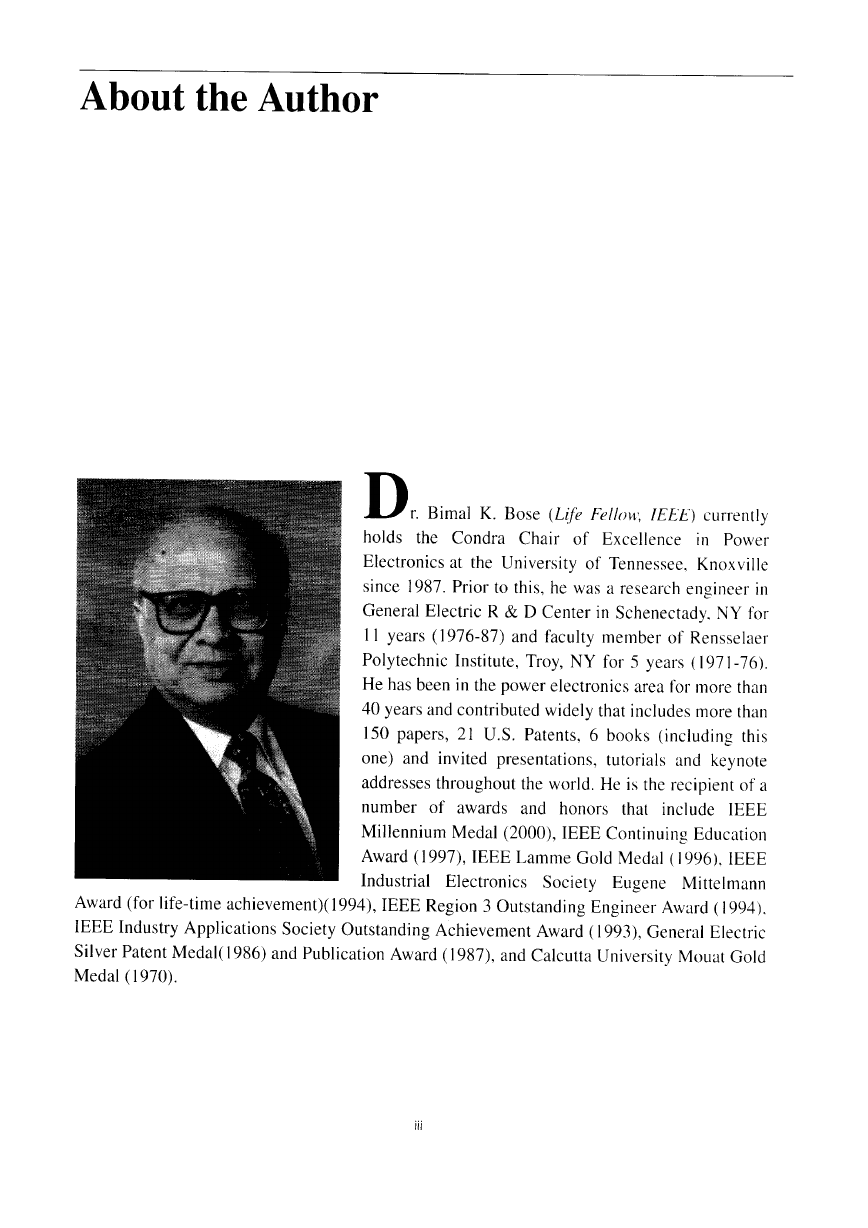

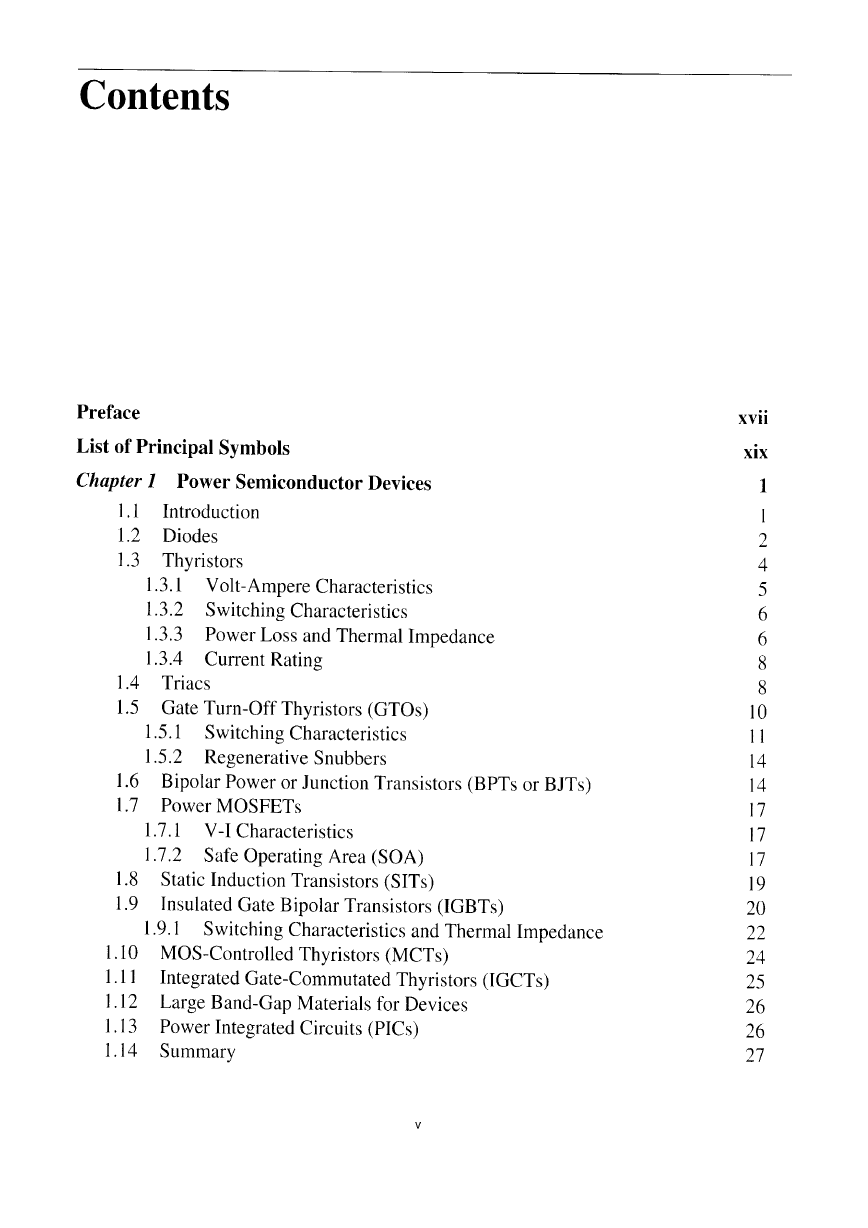
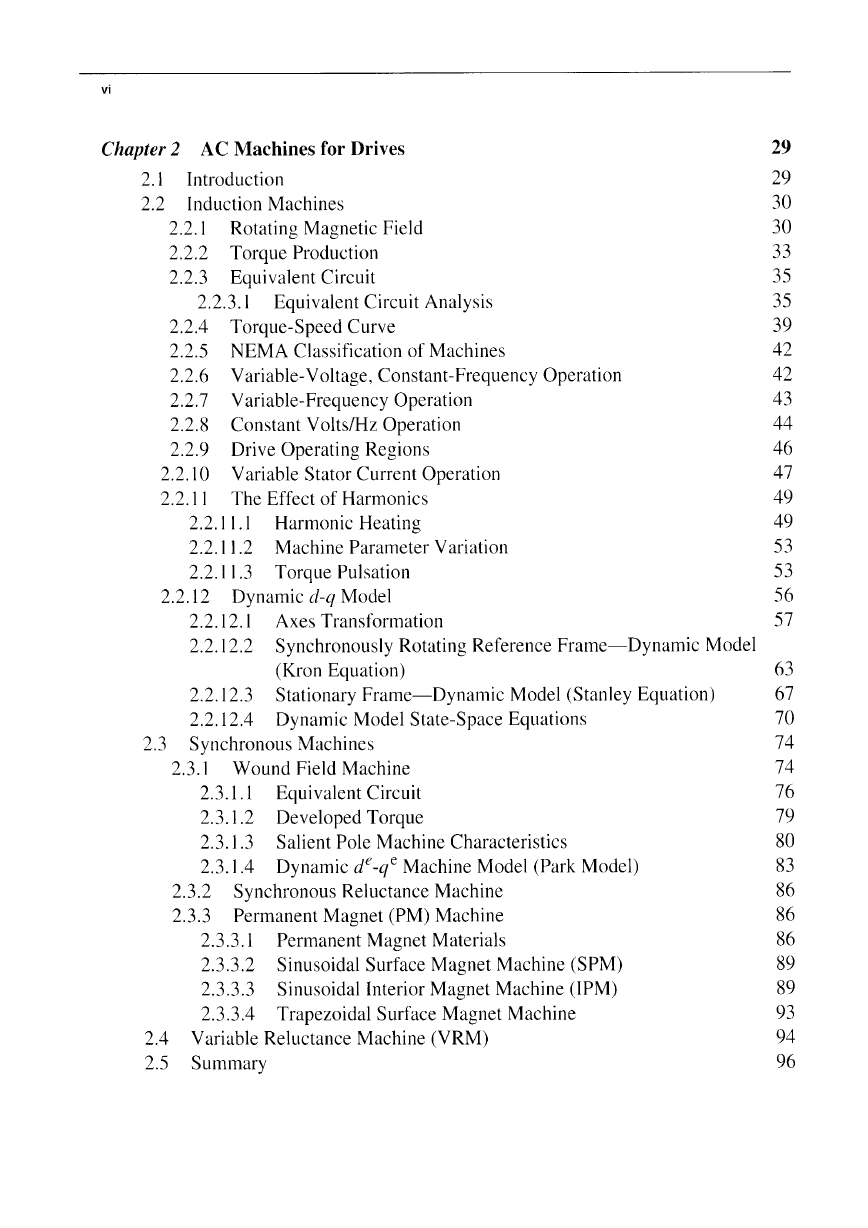








 2023年江西萍乡中考道德与法治真题及答案.doc
2023年江西萍乡中考道德与法治真题及答案.doc 2012年重庆南川中考生物真题及答案.doc
2012年重庆南川中考生物真题及答案.doc 2013年江西师范大学地理学综合及文艺理论基础考研真题.doc
2013年江西师范大学地理学综合及文艺理论基础考研真题.doc 2020年四川甘孜小升初语文真题及答案I卷.doc
2020年四川甘孜小升初语文真题及答案I卷.doc 2020年注册岩土工程师专业基础考试真题及答案.doc
2020年注册岩土工程师专业基础考试真题及答案.doc 2023-2024学年福建省厦门市九年级上学期数学月考试题及答案.doc
2023-2024学年福建省厦门市九年级上学期数学月考试题及答案.doc 2021-2022学年辽宁省沈阳市大东区九年级上学期语文期末试题及答案.doc
2021-2022学年辽宁省沈阳市大东区九年级上学期语文期末试题及答案.doc 2022-2023学年北京东城区初三第一学期物理期末试卷及答案.doc
2022-2023学年北京东城区初三第一学期物理期末试卷及答案.doc 2018上半年江西教师资格初中地理学科知识与教学能力真题及答案.doc
2018上半年江西教师资格初中地理学科知识与教学能力真题及答案.doc 2012年河北国家公务员申论考试真题及答案-省级.doc
2012年河北国家公务员申论考试真题及答案-省级.doc 2020-2021学年江苏省扬州市江都区邵樊片九年级上学期数学第一次质量检测试题及答案.doc
2020-2021学年江苏省扬州市江都区邵樊片九年级上学期数学第一次质量检测试题及答案.doc 2022下半年黑龙江教师资格证中学综合素质真题及答案.doc
2022下半年黑龙江教师资格证中学综合素质真题及答案.doc